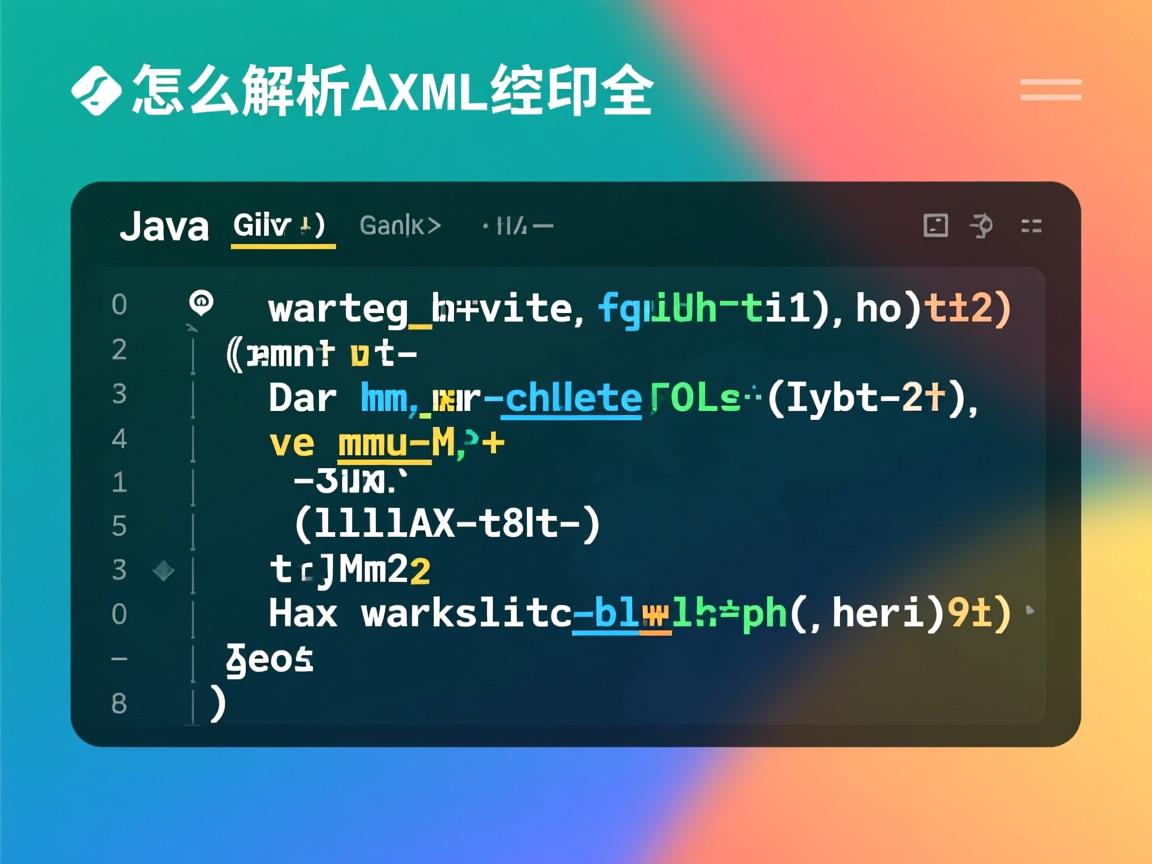va压缩XML文件可使用
ZipOutputStream或
GZIPOutputStream类,将XML文档压缩成ZIP或GZIP格式
Java中压缩XML文件,主要有以下几种常见的方法:
使用ZipOutputStream类进行压缩
ZipOutputStream类可以将XML文档压缩成ZIP文件格式,从而减少文件大小,以下是具体的实现步骤和代码示例:
| 步骤 | 描述 | 代码示例 |
|---|---|---|
| 创建ZipOutputStream对象 | 通过FileOutputStream指定压缩后的文件输出路径,然后将其包装在ZipOutputStream中。 | try (FileOutputStream fos = new FileOutputStream("compressed.zip");<br> ZipOutputStream zos = new ZipOutputStream(fos)) {<br> // 后续操作<br>} |
| 创建ZipEntry对象 | 为要压缩的XML文件创建一个ZipEntry对象,并将其添加到ZipOutputStream中。 | ZipEntry entry = new ZipEntry("file.xml");<br>zos.putNextEntry(entry); |
| 读取并写入XML文件内容 | 使用FileInputStream读取XML文件的内容,然后通过缓冲区将数据写入ZipOutputStream。 | try (FileInputStream fis = new FileInputStream("file.xml");<br> BufferedInputStream bis = new BufferedInputStream(fis)) {<br> byte[] buffer = new byte[1024];<br> int length;<br> while ((length = bis.read(buffer)) > 0) {<br> zos.write(buffer, 0, length);<br> }<br>} |
| 关闭资源 | 关闭ZipOutputStream和相关的输入输出流,以释放资源。 | zos.closeEntry();<br>} |
完整的代码示例如下:
import java.io.;
import java.util.zip.ZipEntry;
import java.util.zip.ZipOutputStream;
public class XmlCompressor {
public static void compressXml(String xmlFilePath, String zipFilePath) throws IOException {
try (FileOutputStream fos = new FileOutputStream(zipFilePath);
ZipOutputStream zos = new ZipOutputStream(fos)) {
ZipEntry entry = new ZipEntry("file.xml");
zos.putNextEntry(entry);
try (FileInputStream fis = new FileInputStream(xmlFilePath);
BufferedInputStream bis = new BufferedInputStream(fis)) {
byte[] buffer = new byte[1024];
int length;
while ((length = bis.read(buffer)) > 0) {
zos.write(buffer, 0, length);
}
}
zos.closeEntry();
}
}
public static void main(String[] args) {
String xmlFilePath = "path/to/your/file.xml";
String zipFilePath = "path/to/save/compressed.zip";
try {
compressXml(xmlFilePath, zipFilePath);
System.out.println("XML file compressed successfully!");
} catch (IOException e) {
e.printStackTrace();
}
}
}
使用GZIPOutputStream类进行压缩
GZIPOutputStream类可以将XML文档压缩成GZIP文件格式,从而减少文件大小,以下是具体的实现步骤和代码示例:

| 步骤 | 描述 | 代码示例 |
|---|---|---|
| 创建GZIPOutputStream对象 | 通过FileOutputStream指定压缩后的文件输出路径,然后将其包装在GZIPOutputStream中。 | try (FileOutputStream fos = new FileOutputStream("compressed.gz");<br> GZIPOutputStream gos = new GZIPOutputStream(fos)) {<br> // 后续操作<br>} |
| 读取并写入XML文件内容 | 使用FileInputStream读取XML文件的内容,然后通过缓冲区将数据写入GZIPOutputStream。 | try (FileInputStream fis = new FileInputStream("file.xml");<br> BufferedInputStream bis = new BufferedInputStream(fis)) {<br> byte[] buffer = new byte[1024];<br> int length;<br> while ((length = bis.read(buffer)) > 0) {<br> gos.write(buffer, 0, length);<br> }<br>} |
| 关闭资源 | 关闭GZIPOutputStream和相关的输入输出流,以释放资源。 | gos.close(); |
完整的代码示例如下:
import java.io.;
import java.util.zip.GZIPOutputStream;
public class XmlCompressor {
public static void compressXml(String xmlFilePath, String gzFilePath) throws IOException {
try (FileOutputStream fos = new FileOutputStream(gzFilePath);
GZIPOutputStream gos = new GZIPOutputStream(fos)) {
try (FileInputStream fis = new FileInputStream(xmlFilePath);
BufferedInputStream bis = new BufferedInputStream(fis)) {
byte[] buffer = new byte[1024];
int length;
while ((length = bis.read(buffer)) > 0) {
gos.write(buffer, 0, length);
}
}
}
}
public static void main(String[] args) {
String xmlFilePath = "path/to/your/file.xml";
String gzFilePath = "path/to/save/compressed.gz";
try {
compressXml(xmlFilePath, gzFilePath);
System.out.println("XML file compressed successfully!");
} catch (IOException e) {
e.printStackTrace();
}
}
}
使用Apache Commons Compress库进行压缩
Apache Commons Compress是一个开源库,提供了多种数据压缩和归档算法的支持,以下是使用该库将XML文件压缩为.tar.gz格式的具体实现步骤和代码示例:
| 步骤 | 描述 | 代码示例 |
|---|---|---|
| 添加Maven依赖 | 如果项目使用Maven进行构建,需要在pom.xml文件中添加Apache Commons Compress库的依赖。 | <dependency><br> <groupId>org.apache.commons</groupId><br> <artifactId>commons-compress</artifactId><br> <version>1.21</version><br></dependency> |
| 创建TarArchiveOutputStream和GzipCompressorOutputStream对象 | 通过FileOutputStream指定压缩后的文件输出路径,先将其包装在GzipCompressorOutputStream中,再包装在TarArchiveOutputStream中。 | try (FileOutputStream fos = new FileOutputStream("compressed.tar.gz");<br> GzipCompressorOutputStream gzos = new GzipCompressorOutputStream(fos);<br> TarArchiveOutputStream taos = new TarArchiveOutputStream(gzos)) {<br> // 后续操作<br>} |
| 创建TarArchiveEntry对象并添加到taos中 | 为要压缩的XML文件创建一个TarArchiveEntry对象,并将其添加到TarArchiveOutputStream中。 | TarArchiveEntry entry = new TarArchiveEntry("file.xml");<br>taos.putArchiveEntry(entry); |
| 读取并写入XML文件内容 | 使用FileInputStream读取XML文件的内容,然后通过缓冲区将数据写入TarArchiveOutputStream。 | try (FileInputStream fis = new FileInputStream("file.xml")) {<br> byte[] buffer = new byte[1024];<br> int length;<br> while ((length = fis.read(buffer)) > 0) {<br> taos.write(buffer, 0, length);<br> }<br>} |
| 关闭资源 | 关闭TarArchiveEntry、TarArchiveOutputStream和相关的输入输出流,以释放资源。 | taos.closeArchiveEntry();<br>taos.finish(); |
完整的代码示例如下:

import org.apache.commons.compress.archivers.tar.TarArchiveEntry;
import org.apache.commons.compress.archivers.tar.TarArchiveOutputStream;
import org.apache.commons.compress.compressors.gzip.GzipCompressorOutputStream;
import java.io.;
public class XmlCompressor {
public static void compressXml(String xmlFilePath, String tarGzFilePath) throws IOException {
try (FileOutputStream fos = new FileOutputStream(tarGzFilePath);
GzipCompressorOutputStream gzos = new GzipCompressorOutputStream(fos);
TarArchiveOutputStream taos = new TarArchiveOutputStream(gzos)) {
TarArchiveEntry entry = new TarArchiveEntry("file.xml");
taos.putArchiveEntry(entry);
try (FileInputStream fis = new FileInputStream(xmlFilePath)) {
byte[] buffer = new byte[1024];
int length;
while ((length = fis.read(buffer)) > 0) {
taos.write(buffer, 0, length);
}
}
taos.closeArchiveEntry();
taos.finish();
}
}
public static void main(String[] args) {
String xmlFilePath = "path/to/your/file.xml";
String tarGzFilePath = "path/to/save/compressed.tar.gz";
try {
compressXml(xmlFilePath, tarGzFilePath);
System.out.println("XML file compressed successfully!");
} catch (IOException e) {
e.printStackTrace();
}
}
}
相关问答FAQs
问题1:Java压缩XML文件时,如果XML文件非常大,可能会导致内存溢出,该如何解决?
答:当处理非常大的XML文件时,为了避免内存溢出,可以采用分块读取和写入的方式,在使用ZipOutputStream或GZIPOutputStream进行压缩时,可以设置一个合适的缓冲区大小(如1024字节或更大),每次读取一部分数据到缓冲区中,然后立即将其写入压缩流中,而不是一次性将整个文件读入内存,这样可以有效地控制内存的使用,防止内存溢出。

问题2:如何在压缩XML文件的同时,对压缩文件进行加密?
答:如果使用ZipOutputStream进行压缩,可以利用其支持密码保护的特性来实现加密,在创建ZipEntry对象时,可以通过setComment方法设置密码注释,或者使用Zip4j等第三方库来更方便地实现加密功能,这些库提供了更多的加密选项和更简单的使用方法,可以满足






